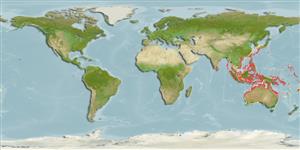Common names from other countries
>
Eupercaria/misc (Various families in series Eupercaria) >
Labridae (Wrasses)
Etymology: Labropsis: Greek, labrax, -akos = a fish, Dicentrarchus labrax + Greek,opsis = appearance (Ref. 45335).
Environment: milieu / climate zone / depth range / distribution range
Ecologia
marinhas associadas(os) a recifes; intervalo de profundidade 5 - 30 m (Ref. 2137), usually 5 - 20 m (Ref. 27115). Tropical; 24°C - 27°C (Ref. 27115)
Indo-West Pacific: Western Australia (Scott Reef) to Papua New Guinea; north to Japan.
Tamanho / Peso / Idade
Maturity: Lm ? range ? - ? cm
Max length : 11.7 cm SL macho/indeterminado; (Ref. 2137)
Espinhos dorsais (total) : 9; Raios dorsais (total) : 11; Espinhos anais: 3; Raios anais : 10; Vértebras: 25. Body of male orangish in life; large females similar in body color with males except for the absence of the large orange area beneath and around the pectoral fin base and the black spot on the dorsal fin. Inconspicuous stripes on head of females; juveniles and small females with 3 broad black stripes on head and body, separated by narrow pale blue stripes. Posterior caudal peduncle and fin principally dark brown or black. Juveniles nearly identical to juveniles of Diproctacanthus but have a longer dorsal fin (Ref. 48636).
Occurs solitary or in small groups (Ref. 90102) in rich coral reefs in clear coastal to outer reef habitats. Adults feed on coral polyps but may also clean (Ref. 48636). Minimum depth range from Ref. 27115.
Ciclo de vida ou comportamento de acasalamento
Maturities | Reprodução | Spawnings | Egg(s) | Fecundities | Larvas
Oviparous, distinct pairing during breeding (Ref. 205).
Randall, J.E., 1981. Revision of the labrid fish genus Labropsis with description of five new species. Micronesica 17(1-2):125-155. (Ref. 2137)
Status na Lista Vermelha da UICN (Ref. 130435)
CITES (Ref. 128078)
Not Evaluated
Ameaça para os humanos
Harmless
Uso pelos humanos
Pescarias: espécies comerciais; Aquário: Espécies comerciais
Ferramentas
Relatórios especiais
Baixar XML
Fontes da internet
Estimates based on models
Preferred temperature (Ref.
115969): 22.9 - 28.9, mean 27.8 (based on 532 cells).
Índice de diversidade filogenética (Ref.
82804): PD
50 = 0.5156 [Uniqueness, from 0.5 = low to 2.0 = high].
Bayesian length-weight: a=0.00955 (0.00456 - 0.02002), b=3.06 (2.89 - 3.23), in cm Total Length, based on LWR estimates for this (Sub)family-body shape (Ref.
93245).
Nível Trófico (Ref.
69278): 3.3 ±0.61 se; based on food items.
Resiliência (Ref.
120179): Elevada, tempo mínimo de duplicação da população menor que 15 meses (Preliminary K or Fecundity.).
Fishing Vulnerability (Ref.
59153): Low vulnerability (10 of 100).
